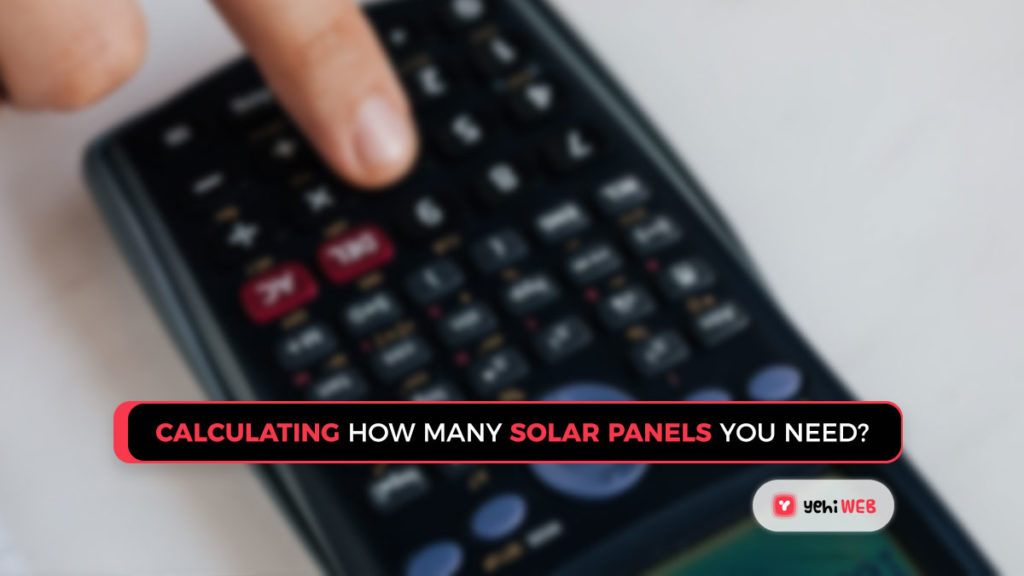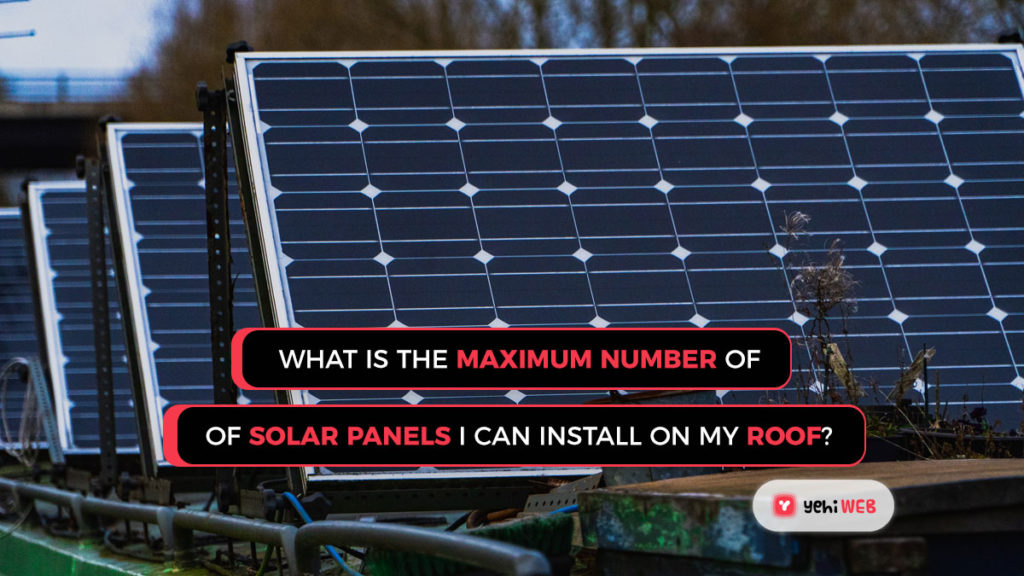You would not be able to reap the financial benefits of a solar panel system if you install one. Although the solution is not always straightforward, On a high level, we have put together some scenarios to help you find out how many solar panels you will need.
You would not be able to reap the financial benefits of a solar panel system if you install one. Although the solution is not always straightforward, On a high level, we have put together some scenarios to help you find out how many solar panels you will need.
Key takeaways
- To completely offset electricity bills with solar, an average home needs between 30 to 35 solar panels.
- This figure is determined by several factors, including geographic location and panel specifications.
To power your home, how many solar panels do you need?
According to our estimates, an average home will need between 30 and 35 solar panels to cover 100 percent of its energy consumption. The exact amount you would need depends on various factors, including your location, panel efficiency, rated power, and personal energy consumption habits.
Calculating how many solar panels you need

We used to figure out how many solar panels you would need to power your home based on three main factors: annual energy consumption, panel wattage, and production ratios. So, what exactly does this imply? Here are our conclusions and how we did our math:
Annual Energy Consumption:
Your annual electricity use is the amount of electricity you consume in your home over the course of a year. This figure, which is measured in kilowatt-hours, is determined by the appliances in your home that use electricity, as well as how much you use them (kWh). Electricity is used for refrigerators, air conditioning units, small kitchen appliances, lights, chargers, and other devices. The average United States household consumes 15,014.8 kWh of electricity each year, so we will use that figure as the ideal solar panel system size, which will mean you could cover 100 percent of your electricity demand with solar panels (in fact, it is not this neat, but bear with us here).
Panel Wattage:
The energy generated by a solar panel under ideal conditions is measured in panel wattage, also known as a solar panel’s power rating. Solar panels typically produce between 250 and 400 watts of power, with wattage measured in watts (W). For these measurements, we will use a 320-watt middle panel.
Output ratios:
A solar panel system’s production ratio is the proportion of the projected energy produced over time (in kWh) to the actual system capacity (in W). The performance level will vary depending on how much sunlight your system receives; these figures are seldom 1:1. (which is primarily determined by your geographic location). E.g., a 10 kW plant that produces 14 kWh of energy over the course of a year has an output ratio of 1.4 (14/10 = 1.4), which is an effective production ratio to see in action. We will use those two numbers as our high and low averages when production levels are usually between 1.3 and 1.6.
Now, let’s do out the math.
Now that we have established our three main assumptions (energy consumption, solar panel wattage, and production ratios), how do we convert those figures into an approximate number of solar panels for your home? The formula is as follows:
- System size/production ratio / panel wattage = number of panels
- We get the following results when we plug in our numbers from above:
- Number of panels = 15,014.8 kW / 1.3 or 1.6 / 320 W
The production ratio we choose gives us between 30 and 35 panels (30 for a 1.6 ratio and 35 for a 1.3 ratio). A total system size of 11 kW is achieved using 35 panels, each rated at 320 W.
How much power can your solar panels produce? Production ratios and their dynamics
The amount of power (kWh) that your solar energy system can produce is determined by the amount of sunlight your roof receives, determining your production ratio. The amount of sun you get in a year is defined by your location in the world and the time of year. However, you will be able to produce enough energy to satisfy your needs regardless of where you live. You will need a more extensive system built at your home if you live in a less sunshine area. As a result, production ratios vary by region, and a lower production ratio (due to less sunlight) means you would need more solar panels to get the energy you need.
How many solar panels would my home necessitate? a comparison of system sizes
| SYSTEM SIZE | NUMBER OF PANELS NEEDED | ESTIMATED ANNUAL PRODUCTION |
|---|---|---|
| 4 kW | 13 | 6,400 kWh |
| 6 kW | 19 | 9,600 kWh |
| 8 kW | 25 | 12,800 kWh |
| 10 kW | 32 | 16,000 kWh |
| 12 kW | 38 | 19,200 kWh |
| 14 kW | 44 | 22,400 kWh |
The table suggests you are using a 320-watt solar panel once more. However, whether you choose low-efficiency panels or high-efficiency panels, the number of panels you use to power your home and the amount of room your system takes up on your roof will change (which generally correlates to low and high power rating, respectively). Based on the power output of the solar panels you choose, the table below will show you how much space your system will take up on your roof.
What is the maximum number of solar panels I can install on my roof?

The scale of the system in terms of square footage
| SYSTEM SIZE | LOW POWER PANELS (SQ. FEET) | AVERAGE POWER PANELS (SQ. FEET) | HIGH POWER PANELS (SQ. FEET) |
|---|---|---|---|
| 4 kW | 240 | 203 | 179 |
| 6 kW | 367 | 305 | 269 |
| 8 kW | 490 | 406 | 358 |
| 10 kW | 612 | 508 | 448 |
| 12 kW | 734 | 610 | 538 |
| 14 kW | 857 | 711 | 627 |
Estimating annual electricity consumption for your home is perhaps one of the most complex facets of sizing a solar panel device. A variety of larger consumer goods or add-ons will drastically alter the annual kWh requirements and, as a result, the number of panels you may need. If you choose to use central air conditioning or fuel a heated swimming pool in your backyard, your solar panel array size will need to be adjusted significantly. It would help determine the energy effect of different items you own or consider for your home and get a sense of the scale you need.
For common appliances, how many solar panels do you need?
When you look at the various kWh requirements for certain household appliances and products, one thing is clear: these add-ons can drastically alter your monthly energy consumption. They could have a big impact on how big a solar panel system you would put up. Combining your electric vehicle with solar panels, for example, is an intelligent way to minimize greenhouse emissions and increase energy efficiency; but, it should be designed accordingly, as it can double the size of your PV system.
Though it is possible to mount a solar system and later add additional panels to meet increased energy demands, the most practical choice is to size the system precisely as possible depending on your anticipated purchases–such as an electric car, swimming pool, or central air system. Any new solar homeowner should make it a routine to ask themselves, “How many solar panels will I need for my refrigerator, hot tub, and other appliances?.”
For individual electricity loads, how many solar panels do I need?
| PRODUCT | AVERAGE ANNUAL KWH REQUIRED | ESTIMATED NUMBER OF SOLAR PANELS NEEDED |
|---|---|---|
| Refrigerator | 600 | 2 |
| Air Conditioning Unit | 215 | <1 |
| Central Air Conditioning | 1,000 | 3 |
| Electric Vehicle | 3,000 | 10 |
| Heated Swimming Pool | 2,500 | 8 |
| Hot Tub (outdoor) | 3,300 | 11 |
When looking for the best solar panels on the market, there are various factors to consider. Although some solar panels have better performance scores than others, spending more money on top-of-the-line solar equipment does not necessarily translate into more savings. The only way to find your property’s “sweet spot” is to evaluate quotes on various equipment and financing choices.
Contact us for a free inquiry to get upfront cost and long-term savings estimates based on your location and roof type for every homeowner in the early stages of shopping for solar and wants a ballpark estimate for an installation.

![How many solar panels are required to run your house [Guide]](https://yehiweb.com/wp-content/uploads/2021/04/how-many-solar-panels-are-required-to-run-your-house-Yehiweb-1200x675.jpg)